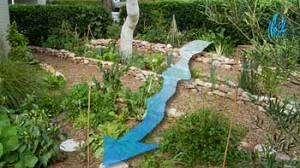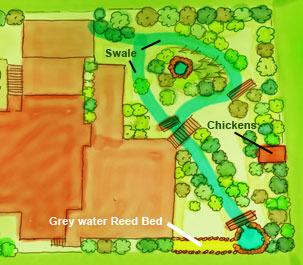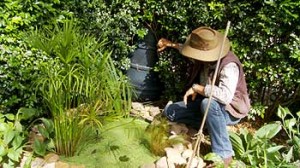Mini Swales in an Urban Backyard
The term “swale” is often used by Permaculture people when designing large earth work constructions but it’s very rarely spoken of in an urban setting.
What is a swale anyway?
Well its commonly defined as “a water harvesting ditch on contour.”
Imagine it as a long wide cup rather than a gutter or drain. You can gain a better idea of how a swale functions by looking at the animation here.
Drains are designed to get rid of water – fast.
Swales are designed to keep water from draining away too fast – they are meant to slow water down to a trickle and keep it from running away so it can be directed to where the water is needed most – keeping your garden plants moist and alive during the hot summer months.
In our Harvesting Water the Permaculture Way DVD we show how swales are created and attached to a dam system on a larger farm setting.
But what about the suburban backyard? Is a swale system needed at all?
 Front Garden
Front Garden
Shooting the Urban Permaculture DVD with Geoff Lawton we came across a magnificent example of great mini swale design in a suburban setting in Sydney.
Here the front garden was surveyed and the contours planned to work with the natural slope of the land.
The roadway was higher then the house, so rain water was directed to flow from the footpath – through two mini swale walkways that fed the front vegetable garden beds and distributed the water out to the backyard.
The roof on the main house also collected rain in a large water tank and directed excess water to a large barrel that was hidden inside the boundary hedge. The barrel would collect and distribute overflow water directly into a small frog pond.
Having water tanks hidden inside a boundary hedges, eliminated seeing their functional industrial look and helped to distribute water runoff around various points in the garden.
In a rain event , the frog pond would overflow and spill water into the top swale and soak water slowly into the top garden beds where the water would seep through to an adjacent swale walkway that would similarly soak the water out into the garden and keep it actively employed in the backyard for as long as possible.
This way, what little water fell on this backyard was used to the benefit of all the garden plants.
The mini swale paths were originally planted out with thick newspapers, heaps of Sunday Editions were used to smother weeds and act as a rotting mulch layer for top dressed tan bark that was layered above to not only look attractive and easy to walk on but to also absorb any excess moisture.
“This is the type of design elements we have to include in all our designs,” says Geoff Lawton, “so we get the best result. Minimum of input, Maximum Output.”
 A garden like this requires minimum maintenance throughout the seasons.
A garden like this requires minimum maintenance throughout the seasons.
“We have contour layers designed into the garden so the water slowly soaks through.” said Geoff Lawton.
As the water runs down the garden it feeds a larger pond which is powered by a little solar powered pump that creates the feel of a natural water fall near the main entry point to the house.
Excess water from this pond helps to direct moisture to the backyard behind the house.
Backyard Garden Swale System
The grey-water system in the backyard collects all the water runoff from the kitchen into another little frog pond positioned in the right top corner of the backyard.
Here the water soaks into the heavily mulched swale trench system that runs adjacent to the house as it loops around an island garden bed to feed an assortment of productive fruit trees.
The island also has its own little pond hidden amongst the overhanging fruit trees.
The owner of this garden has also planned for a chicken coop to be positioned along the boundary fence which will also collect any chicken nutrient runoff and distribute it into the system.
By organizing your suburban backyard into a cascading series of mini swales that help direct water runoff throughout the garden, making it soak into garden beds under the mulch at the root zone will enable you to grow all your vegetables and fruit with minimal additional water. Excess water will also keep the frog ponds active and invite nature back into the garden. It does take a certain amount of Permaculture study, planning and thinking to achieve such a result.
But the end results are well worth the effort as the system matures one can feel the garden merge back with nature even when living in the middle of a heavily urbanized environment.
This garden will be featured in the Urban Permaculture DVD out later in the year that goes into a lot more depth than this blog post allows.











Recent Comments